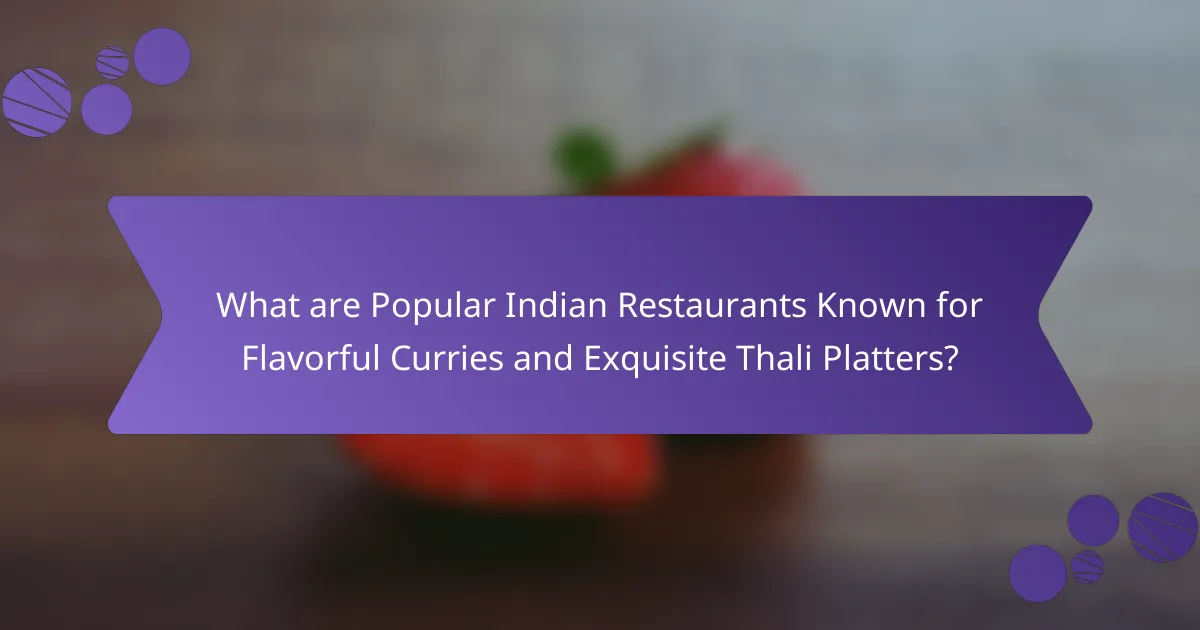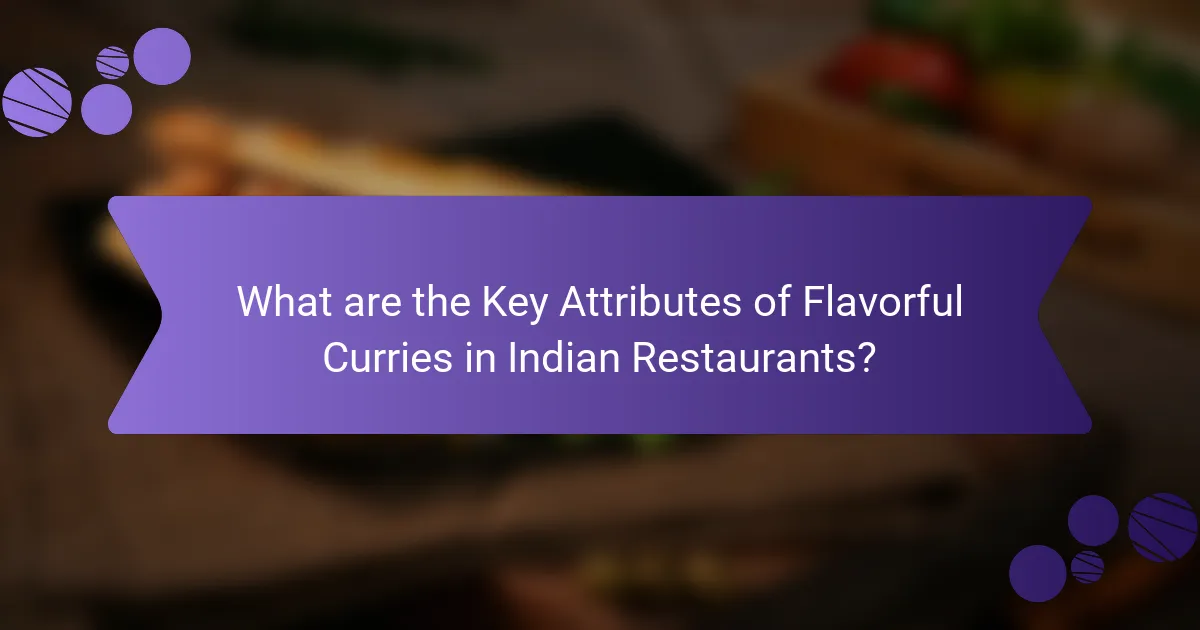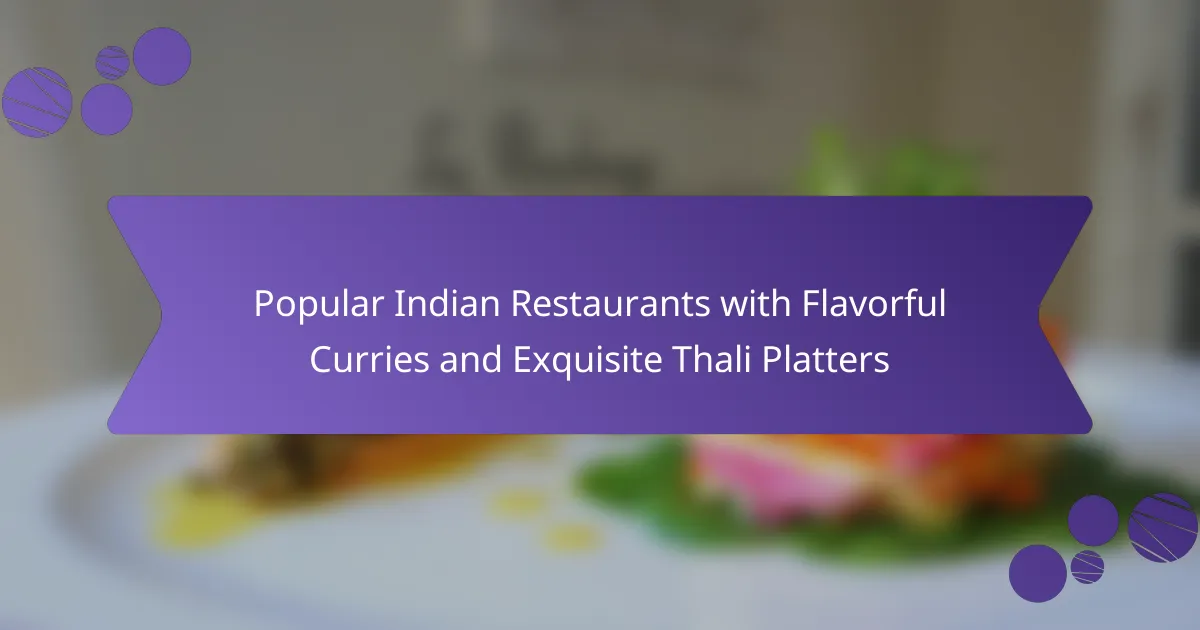
What are Popular Indian Restaurants Known for Flavorful Curries and Exquisite Thali Platters?
Popular Indian restaurants known for flavorful curries and exquisite thali platters include Bukhara, Indian Accent, and Saravana Bhavan. Bukhara is famous for its rich dal makhani and tandoori dishes. Indian Accent offers innovative takes on traditional recipes, including its signature thali. Saravana Bhavan is renowned for its authentic South Indian thali and flavorful curries. These establishments consistently receive high ratings for their unique flavors and presentation. They are often featured in culinary reviews and food guides, highlighting their contributions to Indian cuisine.
How do these restaurants define the Indian dining experience?
These restaurants define the Indian dining experience through authentic cuisine and cultural ambiance. They offer a diverse menu featuring traditional dishes such as flavorful curries and exquisite thali platters. Each dish is prepared using age-old recipes and fresh ingredients, ensuring rich flavors. The dining environment often reflects Indian culture with decor, music, and service style. Many restaurants emphasize communal dining, encouraging sharing of dishes among guests. This approach fosters a sense of community and connection. Additionally, the use of spices showcases India’s culinary heritage, enhancing the overall experience. Overall, these elements create a holistic Indian dining experience that engages all senses.
What makes the curries at these restaurants stand out?
The curries at these restaurants stand out due to their unique blend of spices and fresh ingredients. Each dish is crafted with regional recipes that enhance flavor profiles. Many restaurants use locally sourced produce, ensuring freshness and quality. Authentic cooking techniques, such as slow simmering, deepen the flavors significantly. Some establishments offer specialty curries that are family recipes, adding a personal touch. Additionally, the use of traditional cooking methods, like tandoor ovens, imparts distinct tastes. These factors combine to create a rich and memorable dining experience.
What is the significance of thali platters in Indian cuisine?
Thali platters hold significant cultural and culinary importance in Indian cuisine. They provide a complete meal experience, showcasing a variety of dishes on a single platter. This variety allows diners to taste different flavors and textures. Traditionally, thalis include rice, bread, lentils, vegetables, and sweets. Each component represents regional diversity and culinary traditions. The communal aspect of sharing a thali enhances social interactions during meals. Thalis also reflect the balance of nutrition, offering a well-rounded diet. In many Indian households, a thali is a symbol of hospitality and generosity.
Why are curries and thali platters popular choices among diners?
Curries and thali platters are popular choices among diners due to their rich flavors and variety. Curries offer a diverse range of spices and ingredients, appealing to different taste preferences. Thali platters provide a complete meal experience with multiple dishes on one plate. This variety allows diners to sample different flavors and textures in a single sitting. Additionally, both options cater to vegetarian and non-vegetarian diets, broadening their appeal. The communal nature of sharing a thali enhances the dining experience. Many restaurants focus on authentic recipes, attracting food enthusiasts. Overall, the combination of flavor, variety, and cultural experience contributes to their popularity.
What variety of curries can be found in popular Indian restaurants?
Popular Indian restaurants offer a diverse variety of curries. Common types include Butter Chicken, a creamy tomato-based dish. Tikka Masala is another favorite, featuring marinated chicken in a spiced sauce. Paneer Butter Masala caters to vegetarians with its rich, buttery sauce. Additionally, Rogan Josh presents a flavorful lamb curry, often with aromatic spices. Dal Makhani is a staple, made from black lentils and cream. Vegetable Korma offers a mix of vegetables in a coconut or yogurt sauce. Each curry showcases unique spices and preparation methods. These dishes reflect regional variations and culinary traditions across India.
How do thali platters enhance the dining experience?
Thali platters enhance the dining experience by offering a diverse array of flavors and textures in one meal. Each platter typically includes multiple small servings of different dishes, such as curries, vegetables, and rice. This variety allows diners to sample a wide range of traditional Indian cuisine. The presentation of thali platters is visually appealing, often featuring vibrant colors and intricate arrangements. Sharing a thali platter encourages communal dining, fostering a sense of togetherness among guests. Additionally, thali platters often reflect regional specialties, providing a cultural experience. This combination of variety, presentation, and cultural significance makes thali platters a unique dining option.

What are the Key Attributes of Flavorful Curries in Indian Restaurants?
Key attributes of flavorful curries in Indian restaurants include rich spices, balanced flavors, and diverse ingredients. Spices like cumin, coriander, and turmeric are essential for depth. The balance between heat and sweetness enhances overall taste. Fresh ingredients, such as herbs and vegetables, contribute to texture and nutrition. Various cooking techniques, like slow simmering, develop complex flavors. Regional variations introduce unique profiles, such as coconut in South Indian curries. Authentic recipes often rely on traditional methods, ensuring consistency in taste. These attributes combine to create the signature richness of Indian curries.
What ingredients contribute to the unique flavors of these curries?
Spices and herbs contribute to the unique flavors of curries. Common ingredients include cumin, coriander, turmeric, and garam masala. Cumin adds earthy notes, while coriander provides citrus undertones. Turmeric imparts a warm color and subtle bitterness. Garam masala is a blend of spices that enhances depth and complexity. Additionally, ingredients like ginger and garlic bring warmth and aroma. Coconut milk or yogurt can add creaminess and balance the spices. These combinations create distinct flavor profiles in various curry dishes.
How does the cooking method influence the taste of curries?
The cooking method significantly influences the taste of curries. Different techniques, such as simmering, frying, or baking, alter flavor profiles. Simmering allows spices to meld, enhancing complexity. Frying can intensify flavors through caramelization. Baking may create unique textures and flavors not achieved through stovetop methods. Each method also affects ingredient tenderness. Slow cooking breaks down proteins, making them more flavorful. High-heat methods can create a smoky taste. The choice of cooking method can highlight or mute specific spices. Thus, the cooking method is crucial in determining the overall taste of a curry.
What role do spices play in creating flavorful curries?
Spices are essential in creating flavorful curries. They provide depth and complexity to the dish. Common spices include cumin, coriander, turmeric, and garam masala. Each spice contributes unique flavors and aromas. For example, cumin adds earthiness while turmeric brings warmth and color. The combination of spices creates a balanced taste profile. Additionally, spices can enhance the nutritional value of curries. They contain antioxidants and anti-inflammatory properties. The careful selection and blending of spices is what makes curries distinctive and enjoyable.
What types of curries are most commonly served in these restaurants?
The most commonly served types of curries in popular Indian restaurants include Chicken Tikka Masala, Paneer Butter Masala, and Lamb Rogan Josh. Chicken Tikka Masala features marinated chicken in a spiced tomato cream sauce. Paneer Butter Masala consists of paneer cooked in a rich, buttery tomato gravy. Lamb Rogan Josh is a slow-cooked lamb curry with aromatic spices. Other popular curries include Chana Masala, a chickpea curry, and Dal Makhani, made with black lentils and cream. These dishes are staples in Indian cuisine and are frequently featured on restaurant menus.
How do vegetarian and non-vegetarian curries differ?
Vegetarian and non-vegetarian curries differ primarily in their main ingredients. Vegetarian curries primarily use vegetables, legumes, and dairy products. Common ingredients include potatoes, spinach, lentils, and paneer. Non-vegetarian curries, on the other hand, include meat, poultry, or seafood as the main component. Popular choices are chicken, lamb, and fish.
The cooking methods can also vary. Vegetarian curries often rely on spices and herbs to enhance the flavors of vegetables. Non-vegetarian curries utilize the natural flavors of the meat, often complemented by spices.
Nutritional profiles differ as well. Vegetarian curries are typically lower in calories and saturated fats. Non-vegetarian curries may provide more protein but can also be higher in fats.
Cultural preferences often influence choices. Many regions have traditional vegetarian curries, while others are known for their non-vegetarian dishes. This diversity contributes to the rich culinary landscape of Indian cuisine.
What are some regional variations of curries found in Indian cuisine?
Indian cuisine features various regional variations of curries. Each region showcases unique flavors and ingredients. For example, North Indian curries often include rich gravies made with dairy, like butter chicken. In contrast, South Indian curries frequently use coconut milk and tamarind, such as in Kerala’s fish curry. East Indian curries, like those from Bengal, often highlight mustard oil and include fish. West Indian curries, particularly from Gujarat, are known for their sweet and spicy profiles, incorporating jaggery. Each of these regional variations reflects local agricultural practices and cultural influences.

What are the Unique Attributes of Exquisite Thali Platters?
Exquisite thali platters possess unique attributes that set them apart from standard meal presentations. They typically feature a diverse array of dishes, showcasing regional specialties. Each platter is designed to provide a balanced meal, incorporating various flavors and textures. The presentation is often vibrant, enhancing visual appeal. Unique thali platters may also include traditional accompaniments like pickles and chutneys, which elevate the dining experience. Additionally, the use of authentic serving utensils, such as small bowls and decorative plates, adds cultural significance. These attributes contribute to the overall experience of enjoying Indian cuisine in a communal setting.
What components typically make up a thali platter?
A thali platter typically consists of a variety of dishes served on a single plate. It usually includes rice, dal (lentils), vegetables, and roti (bread). Additionally, it may feature a curry or meat dish, pickles, and a sweet dessert. The components can vary regionally across India. For example, a North Indian thali often includes paneer dishes, while a South Indian thali may feature sambar and rasam. The assortment allows for a balanced meal with diverse flavors and textures.
How does portion size and variety enhance the thali experience?
Portion size and variety significantly enhance the thali experience by providing a balanced and diverse meal. A well-constructed thali typically includes multiple small servings of different dishes. This allows diners to sample a range of flavors and textures in one meal. The variety caters to different taste preferences and dietary needs.
Research shows that meals with diverse components can lead to higher satisfaction levels among diners. The portion sizes are designed to be manageable, preventing waste while allowing for multiple tastings. This format encourages social dining, as sharing becomes a natural part of the experience.
In Indian culture, the thali represents hospitality and abundance. The combination of portion size and variety creates a visually appealing presentation, enhancing the overall dining experience.
What cultural significance do thali platters hold in Indian meals?
Thali platters hold significant cultural importance in Indian meals. They represent a balanced meal, showcasing a variety of dishes. Each thali typically includes rice, bread, vegetables, lentils, and sweets. This diversity reflects India’s culinary heritage and regional variations. Thali platters promote communal dining, encouraging sharing among family and friends. Traditionally, they symbolize hospitality and generosity in Indian culture. The presentation of a thali is often colorful and vibrant, enhancing the dining experience. Festivals and special occasions frequently feature thali platters, highlighting their cultural relevance.
How can diners choose the best thali platter for their tastes?
Diners can choose the best thali platter by considering their flavor preferences and dietary restrictions. First, they should identify their favorite regional cuisines, as thali platters vary by region in India. For example, North Indian thalis often feature rich curries, while South Indian thalis include rice and sambar. Next, diners should assess the variety of dishes included in the thali. A well-balanced thali offers a mix of flavors, textures, and nutrients. Additionally, they should inquire about spice levels to match their tolerance. Diners can also look for thalis with seasonal ingredients for freshness. Lastly, reading reviews and asking for recommendations from restaurant staff can guide them to popular choices.
What should one look for when selecting a thali platter?
When selecting a thali platter, one should look for variety, balance, and quality of dishes. A good thali includes multiple components such as curries, lentils, rice, and bread. This variety ensures a comprehensive tasting experience. Balance is crucial; the platter should offer a mix of flavors, textures, and nutritional value. Quality is essential; fresh ingredients enhance taste and authenticity. Additionally, consider regional specialties that reflect local culinary traditions. Finally, presentation matters; an appealing arrangement enhances the dining experience.
How can dietary preferences influence thali platter choices?
Dietary preferences significantly influence thali platter choices by determining the selection of dishes included. Vegetarians typically prefer thalis with a variety of vegetable curries, lentils, and paneer dishes. Vegan diners opt for plant-based options, avoiding dairy and meat, leading to thalis featuring more legumes and vegetables. Gluten-free individuals may choose thalis that exclude wheat-based breads like naan or roti.
Additionally, those with specific dietary restrictions, such as nut allergies, will require thalis that do not include nut-based ingredients. Cultural dietary practices, such as Jainism, influence choices by eliminating root vegetables and certain spices.
Restaurants often customize thali platters based on these preferences, ensuring a diverse and satisfying meal for all dietary needs. This adaptability is essential in catering to a broad audience in popular Indian restaurants.
What are some Tips for Enjoying Curries and Thali Platters at Indian Restaurants?
To enjoy curries and thali platters at Indian restaurants, start by sampling a variety of dishes. This allows you to experience different flavors and textures. Pair your meal with naan or rice to balance the richness of curries. Use your hands if comfortable, as it’s traditional and enhances the dining experience. Take small bites to savor each dish fully. Don’t hesitate to ask for recommendations from the staff; they can guide you to popular choices. Drink lassi or chai to complement the spices in your meal. Finally, share your thali platter with others; this encourages tasting a wider range of dishes.
How can diners pair curries with the right beverages?
Diners can pair curries with beverages by considering the flavor profile of the curry. For spicy curries, a cooling beverage like yogurt-based lassi or coconut water works well. These drinks help balance heat and enhance the dining experience. For rich, creamy curries, a light beer or a crisp white wine complements the dish without overpowering it.
When enjoying tomato-based curries, a medium-bodied red wine can accentuate the dish’s acidity. Additionally, herbal teas can provide a refreshing palate cleanser between bites. These pairings are supported by culinary traditions that emphasize balancing flavors and enhancing enjoyment.
What etiquette should be followed while enjoying a thali platter?
When enjoying a thali platter, use your right hand to eat. This practice is rooted in Indian culture, emphasizing a connection with food. Wash your hands before and after the meal to maintain hygiene. Take small portions from each dish to savor the variety. Avoid mixing all the dishes together; instead, taste them separately. If served with a spoon, use it for liquid items like curries. Wait for the host to start eating before you begin. Respectfully decline any food you cannot eat due to dietary restrictions.
Popular Indian restaurants known for flavorful curries and exquisite thali platters include Bukhara, Indian Accent, and Saravana Bhavan. These establishments are celebrated for their unique flavors, authentic recipes, and cultural ambiance, offering a diverse menu that features traditional dishes prepared with fresh ingredients. The article explores the significance of curries and thali platters in Indian cuisine, highlighting their rich flavors, variety, and communal dining experience. Additionally, it discusses the attributes that make these dishes stand out, including the role of spices, cooking methods, and regional variations, providing insights into how diners can enhance their experience while enjoying these culinary delights.




